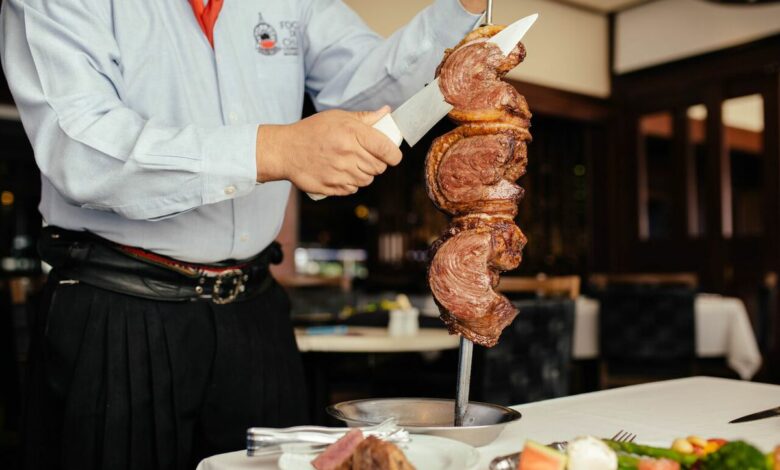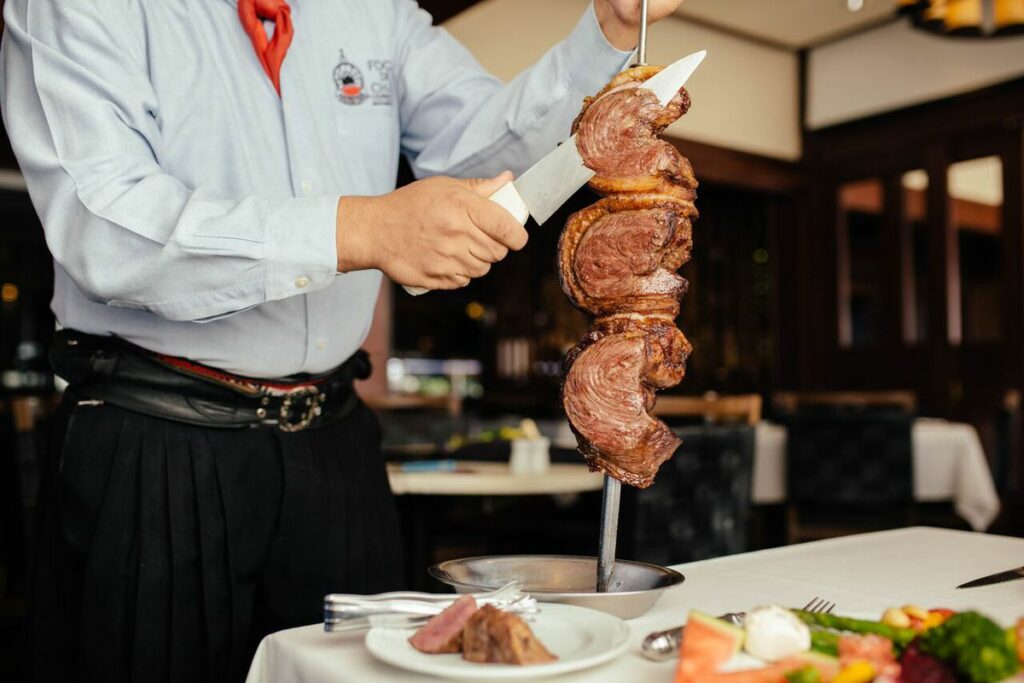Brazilian Steakhouse: Secrets You Never Knew

If you’ve ever visited a Brazilian steakhouse, you are probably familiar with the delicious meals they serve there. Succulent skewers of meat that are sliced directly onto your plate. An abundance of unlimited options; tart garnishes, caramelized plantains, and other delicious meat recipes. However, have you ever stopped to consider the magic that happens behind the scenes of the Brazilian steakhouse and the reasons it is so different from a typical American steakhouse?
The proper term for it is a churrascaria, even if some people may refer to it as a Brazilian steakhouse. The word “barbecue” is derived from the Portuguese and refers to the method of cooking the meat. The term “churrasco style” refers to simply grilling the meat over an open flame. Using a skewer is a popular method of grilling meat churrasco style.
We delved into the reasons for the enormous popularity of this cooking method in Brazil, its journey to America, and the reason behind the seemingly never-ending supply of meat. These are a few Brazilian steakhouse secrets you may not have known.

#1 The most popular Brazilian steakhouse chain in America is called Fogo de Chão.
Fogo de Chão is a full-service Brazilian churrascaria that serves rodízio-style food directly at your table. This makes it one of the most well-liked Brazilian steakhouse options in America. It was founded by two brothers who grew up in Serra Gaucha on a traditional Southern Brazilian farm. They built their first establishment in Porto Alegre in 1979 after obtaining professional churrasquerio training. Fogo arrived in America quickly, setting up shop in Dallas, Texas. Today, the company has over 60 restaurants operating throughout the United States, Brazil, Mexico, and the Middle East.
#2 Barbecue in Brazil has roots in the 1800s.
The gauchos are credited with creating the churrasco cooking method in the 1800s. These were rural nomad horseback riders who wrestled cattle for their meat. Their steak became even more flavorful when they started roasting it on skewers over an open flame. After that, they would bring their beef skewers home to share with loved ones. They would serve the meat “rodízio,” carved straight off the skewer. Brazilian steakhouses continue to serve food in this manner all over the world.
#3 There are around 20 distinct varieties of meat available.
Large churrascarias will let you choose from up to 20 different types of beef for your meal, according to CNN. Prime sirloin (picanha), top sirloin (alcatra), baby beef, filet com alho (filet mignon with garlic), rump steak (maminha), and beef short ribs (costela de Ripa) are the most popular options. Additionally, non-beef choices such as pig loin, sausage, lamb, poultry, and fish will be available at churrascarias.
#4 The most ordered meat from Brazil is picanha.
The picanha, or top of the rump, is a popular cut of beef among Brazilians. Usually, it is served with rice and beans and thinly sliced. Some Brazilian steakhouses serve picanha sliced off of a big skewer that has been slow-roasted over charcoal in a rotisserie fashion after being grilled. Moreover, after browning the top layer, the meat is cut and served raw.
#5 Another well-liked non-beef option is lumpo.
Pig loin, or lombo, is the next most popular alternative if you’re not a huge fan of steak. Only the tastiest loin slices are kept to grill and serve, thus, the meat is coated with a parmesan cheese mixture.
#6 The majority of steakhouses in Brazil provide unlimited meat selections.
Brazilian steakhouses are sometimes referred to as buffets. This is because of their origins as family-style restaurants that provide a wide selection of dishes, including an extensive menu of meats. However, the meats are served rodízio style, which entails putting the cut meats straight onto the plates of the patrons.
#7 Brazilian steakhouses don’t always have to be cheap dining options.
A more affordable option is the classic experience, which consists of an abundance of meats such as filet mignon, chicken, pork sausage, and even lamb that are served till you say stop. Additionally, you can try some of the more expensive cuts from Fogo de Chao, like as the Wagyu N.Y. Strip or Ribeye, which are both aged for at least 21 days. However, the prices for these cuts are higher. A minimum of 42-day-aged Dry-Aged Tomahawk Ancho steak is also available from the chain.
#8 To counterbalance the flavor of fatty meats, acidic sides options are provided with them.
Molho campanha, a Brazilian salsa, is one of the most popular side dishes. It is usually made with tomatoes, red and green bell peppers, and onion and dressed with vinaigrette. Churrasco-style meats are generally fatty and go well with acidic accompaniments. These include caipirinhas, which are national cocktails and are made with cachaça, a native Brazilian alcoholic beverage, sugar, and lime.








One Comment